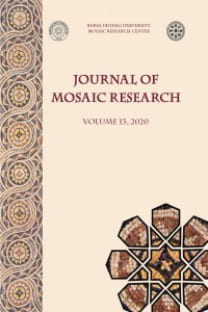Batı Roma Lusitania Epigrafik Anıtlar Üzerinde Doğudan Yansımalar
Batı Lusitania’daki Roma Dönemi epigrafik anıtlarında kişilerin Grek adlarının kullanılması gibi doğu etkilerinigörmek mümkündür. Fakat bu etki bölgede doğu kökenli insanların var olduğu şeklinde yorumlanmamalıdır.Bu sadece kültürel bir etkileşimin sonucudur. Bununla birlikte konuyla ilgili en belirgin doğu etkisi, özellikletanrıların anası olan Kybele kültünün benimsenmesinde görülmektedir. Fakat mozaikler üzerinde de bu doğuetkisinin görülmesi mümkündür.
Anahtar Kelimeler:
Roma epigrafisi, Roma Lusitaniası, Grek adları, Kybele, crinobolium
Reflections of the Orient on the Epigraphic Monuments of Western Roman Lusitania/Reflets de l’Orient sur les Monuments Épigraphiques de la Lusitanie Romaine Occidentale
In the Roman epigraphic monuments of the Occidental Lusitania we can see the oriental influence in theadoption of Greek names by the people there mentioned, but this is a cultural influence not the sign of theexistence of oriental people in the province. Nevertheless the most relevant relation with the oriental culture ispatented at the domain of the religion, especially in the cult of Cybele, as Mother of the Gods. But we can alsosee the oriental influences in the mosaics.
Keywords:
Roman epigraphy, Roman Lusitania, Greek names, Cybele, crinobolium,
___
- J. Alvar Ezquerra, 1993, “Integración social de esclavos y dependientes en la Península Ibérica a través de los cultos mistéricos”, J. Annequin – M. Garrido-Hory (eds.), Religion et Anthropologie de l’Esclavage et des Formes de Dépendance. Besançon, Presses Universitaires de Franche-Comté, 275-293.
- A. M. Davies, 2000, “Greek personal names and linguistic continuity”, S. Hornblower – E. Matthews (eds.), Greek personal names – Their value as evidence. Oxford, British Academy, 15-39.
- J. d’ Encarnação, 2011, “Da onomástica grega na Lusitânia romana”, Uma Trajetória na Grécia Antiga, Homenagem à Neyde Theml. Rio de Janeiro, Apicuri, 301-312.
- J. d’ Encarnação – J. C. L. Faria, 2002, “O santuário romano e a defixio de Alcácer do Sal”, J. Cardim Ribeiro (coord.), Religiões da Lusitânia – Loquuntur Saxa. Lisboa: Museu Nacional de Arqueologia, 259-263.
- R. Étienne, 1977, “Remarques sur l’onomastique romaine d’Espagne”, H.-G. Pflaum – N. Duval (eds.), L’Onomastique Latine (Actes du Colloque International sur l’Onomastique Latine organisé à Paris du 13 au 15 Octobre 1975), Paris, CNRS, 291-292.
- IRCP = Encarnação 1984 J. d’ Encarnação, Inscrições Romanas do Conventus Pacensis. Coimbra: Instituto de Arqueologia.
- R. Parker, 2000, “Theophoric names and the history of Greek religion”, S. Hornblower – E. Matthews, Greek personal names – Their value as evidence. Oxford: British Academy, 53-79.
- M. J. Pena – J. Carbonell, 2006, “Un interesante carmen epigraphicum de Pax Iulia (Portugal)”, Revista Portuguesa de Arqueologia 9/2, 259-270.
- A. M. Vázquez Hoys, 2003, Arcana Magica (Diccionario de símbolos y términos mágicos), Madrid, UNED Ediciones.
- ISSN: 1309-047X
- Başlangıç: 2008
- Yayıncı: Ululdağ Üniversitesi, Mozaik Araştırlmaları Merkezi
Sayıdaki Diğer Makaleler
Mértola Dini Kompleksi (Portekiz) Mozaiklerindeki Geometrik Temalar
Virgílio António Martins LOPES
Batı Doğu ile Buluşuyor: Ionia’nın Roma Mozaikleri
António Manuel de Carvalho LIMA
Penela, Portekiz’de Yer Alan São Simão Roma Villası’ndan Mozaikler
Sónia VICENTE VICENTE, Ana Luísa MENDES
Hispanik Meseta Norte’ninMozaikleri: Evreler, Atölyeler, Sanatsal Yönü
Fernando REGUERAS, Caridad SAN JOSÉ
Kırsal Kentler: Lusitania Villaları’nda Dekoratif Programlar ve Mimari Modeller
Ansião Belediyesi (Portekiz), Santiago de Guarda Anıtsal Kompleksi’ndeki Roma Villası Mozaikleri
